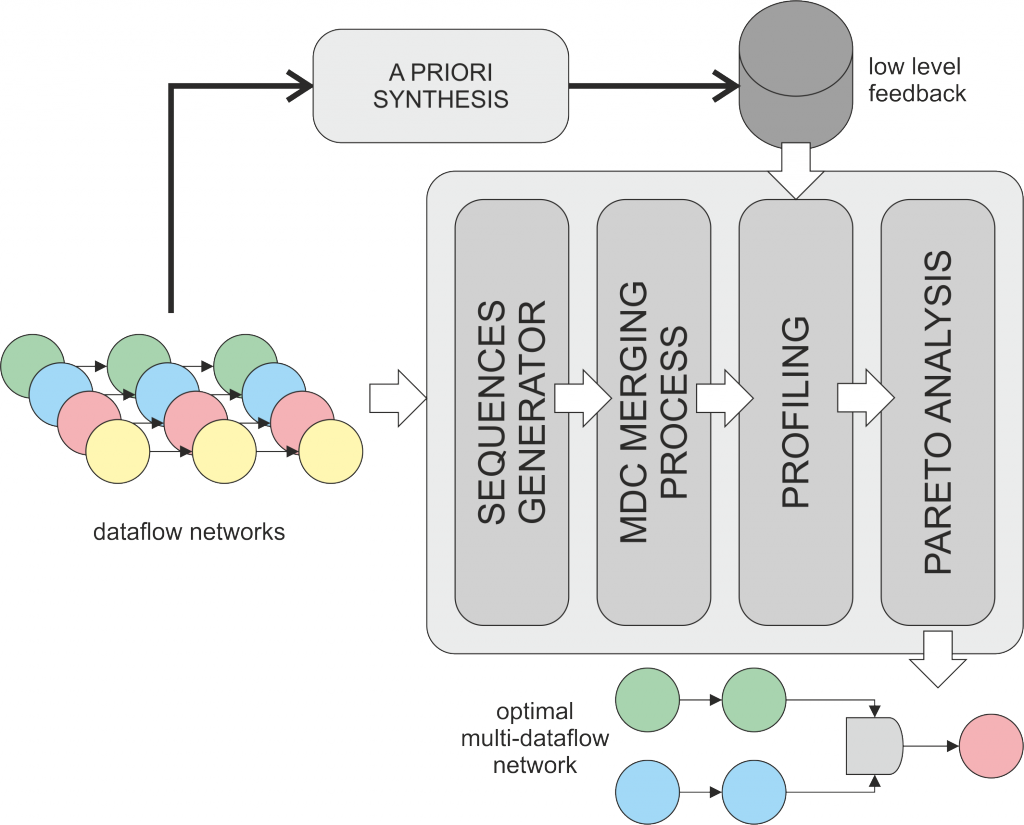it
Il tool MDC è dotato di un’estensione che mira all’ottimizzazione della piattaforma generata attraverso un profiler basato sulla Design Space Exploration (DSE). Con l’espressione DSE si intende la ricerca di tutte le possibili configurazioni alternative del sistema in fase di progettazione, e la loro analisi allo scopo di trovare l’alternativa migliore date le specifiche del sistema.
MDC, durante il merging, ricerca tutte le differenti soluzioni possibili associando ad ognuna di esse una stima in termini di area occupata, frequenza massima di funzionamento e potenza dissipata. I dati di partenza per effettuare tali stime sono ricavati, al momento, da sintesi effettuate a priori sulle reti isolate.
La soluzione ottimale sarà quella che presenta il compromesso migliore tra le metriche considerate fissato uno specifico obiettivo di progetto (minimizzazione di area e potenza dissipata o massimizzazione della frequenza operativa). La ricerca della soluzione ottimale è necessaria in quanto, differenti sequenze di fusione possono portare a catene di SBox diverse, con conseguenti effetti sulla frequenza di funzionamento del sistema. Conseguentemente, si potrebbe decidere di fare il merge solo di un sottoinsieme di reti per migliorare la frequenza operativa del sistema finale (riducendo la lunghezza dei percorsi critici dovuti alle Sbox) a patto di rispettare i vincoli di area e potenza (che possono essere negativamente influenzati da una condivisione inferiore di risorse).
Le fasi del DSE-based profiling associato al tool MDC, schematizzate in figura, sono:
- Sequences generator: generazione di tutte le sequenze delle reti dataflow in ingresso per cui ci può essere un cambiamento nella rete multi-dataflow generata da MDC. In particolare viene fatto variare il numero delle reti fuse e il loro ordine.
- MDC merging process: per ogni sequenza generata dal sequences generator viene generata una diversa rete multi-dataflow dal tool MDC.
- Profiling: ad ogni rete multi-dataflow è assegnato un valore di stima in termini di area occupata, potenza dissipata e massima frequenza operativa.
- Pareto analysis: la distribuzione delle stime associate a ciascun punto del design space vengono analizzate attraverso dei grafi che mettono a confronto, due alla volta, le tre metriche analizzate. In relazione all’obiettivo fissato dall’utente (minimizzazione di area occupata e potenza dissipata o massimizzazione della frequenza operativa) viene identificata la rete multi-dataflow ottimale.
Alla fine di questa analisi, la specifica multi-funzionale di alto livello selezionata potrà essere mappata in hardware dal back-end di MDC.
Per maggiori dettagli riguardo gli algoritmi implementati dal DSE-based profiler: DSE and Profiling of Multi-Context Coarse-Grained Reconfigurable Systems.
en
The MDC tool comes with an extension that aims to optimize the generated platform through a profiler executing an accurate Design Space Exploration (DSE). The term DSE indicates a search of all possible alternative configurations of the system under construction and their analysis in order to define the best alternative according to the given design constraints.
MDC, while merging the input specifications, search for all the different possible configurations associating to each of them an estimate in terms of area occupation, maximum operating frequency and power dissipation. These estimations, at the moment, are retrieved from an a priori synthesis of the separate isolated system.
The optimal solution will be one that presents the best compromise between the considered metrics according to the given project constraints (minimization of area and power loss or maximization of the operating frequency).
The searching phase of the optimal solution is necessary because, different input sequences can lead to different chains of Sboxes in the merged specification, with consequent effects on the operating frequency of the system. Consequently, you might decide to merge only a subset of networks to improve the operating frequency of the final system (reducing the length of the critical path due to the Sbox modules) provided that you still comply with the area and power constraints (which may be adversely affected by a lower degree of resources sharing).
The phases of the DSE-based profiling associated to the tool MDC are schematized in the figure and described hereafter:
- Sequences generator: it generates all the sequences of the incoming dataflow networks that can determine a change in the resulting multi-dataflow network generated by MDC. In particular, these modifications can be determined varying the number of networks to be merged and their order.
- MDC merging process: for each sequence generated by the sequences generator this phase generates a different multi-dataflow network leveraging on the standard MDC flow.
- Profiling: each multi-dataflow network is characterized in terms of area occupied, power dissipation and maximum operating frequency.
- Pareto analysis: the distribution of the power area and frequency estimations, associated with each point of the design space, are analyzed through the graphs that compare, two at a time, the three estimated metrics. According to the constraints set by the user (minimization of occupied area and power loss or maximisation of the operating frequency) the optimal multi-dataflow network is identified.
At the end of this analysis, the high-level multi-functional optimal specification will be mapped in hardware adopting the MDC back-end.
For further details about the algorithms implemented by the DSE-based profiler please refer to the related article: DSE and Profiling of Multi-Context Coarse-Grained Reconfigurable Systems.
.
